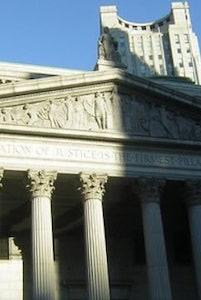in an Accounting System
Civil Litigation
Introduction

Litigation is not a fun thing. Families don’t take vacations by spending two weeks in thier local courthourse watching justice served. This guide is designed to help potential litigants understand various segments of law.
I have divided this article into four parts:
- The Event That May Lead to Litigation
- Welcome to the Courthouse, the Doors are Always Open (or are They?)
- Discovery
- Trial
This paper gives a birds eye view of the litigation process.
A Man Walks Into the Long Island Railroad…
For example, take the man who walked into the Long Island Railroad station. He purchased his ticket and the agent said hurry, you might be able to make the next train. The man, carrying a package, starts running towards the track. He goes down the stairs to the platform and sees that the train is slowly starting to pull out of the station. He starts running to catch the train, holding on to his package. Two porters motion him to run and extend their hands out to help him on the train. The man takes their hands, but in the process, drops the package that he was carrying.

While all this is going on, Mrs. Palsgraf was walking along a platform minding in her own business while waiting for a train to take her and her two daughters to the beach. Unfortunately, the package that the man was carrying contained some type of fireworks or explosive. When he dropped his package it fell onto the tracks and exploded. The percussion that resulted from the explosion knocked over a large-scale that fell on Mrs. Palsgraf. Thus we have Palsgraf v. Long Island Railroad Co., 248 N.Y. 339, 162 N.E. 99 (1928). Palsgraf has caused sleepless nights for many first year law students.
There is Always a Trigger
that sparks a lawsuit. Sometimes the trigger occurs within the event, such as the conduct of the Long Island Railroad employees in the case involving Mrs. Palsgraf. Other times it can be in the form of defective design of the lawnmower. It might occur when someone walks on private property. Regardless, there is always a trigger.
Injury
Injury occurs when someone is hurt, economically, physically, or both. For example, assume that the manufacturer of the lawnmower failed to design a discharge chute that would protect people from a rock that the blade might hit hurl it out into the air causing injury. The negligently designed discharge shoot may go unnoticed for years. But if a child was hit and injured by a rock coming from the lawnmower then you have the makings of a lawsuit.
Damages
The next element that the plaintiff must prove is damages. Were the damages proximately caused by the negligent design of the discharge shoot? This leads us back to Palsgraf.
Mrs. Palsgraf sued the Long Island Railroad on a claim of negligence, among other things. The negligence that Mrs. Palsgraf claimed was the porters helping the man onto the moving train. As a result of this act of negligence the man dropped the package containing explosive which resulted in the package exploding, causing the scale to fall on Mrs. Palsgraf. Mrs. Palsgraf claimed that the natural sequence of events caused her injury.
Obviously, the Long Island Railroad took a different view. The railroad relied on, and the court adopted argument of the foreseeability of the event. Was it foreseeable that, helping a passenger onto a train would result in a scale falling on Mrs. Palsgraf? The court answered no. It was not foreseeable that helping someone on the train would result in a scale falling on Mrs. Palsgraf.
In most instances, the attorney seeks to find damages that were proximately caused by the defendant. Moreover, the attorney should make sure that the defendant has the ability to pay those damages. Sure, Mrs. Palsgraf could have successfully sued the passenger carrying the explosives. But that individual did not have enough money to satisfy an award in Mrs. Palsgraf’s favor. Lawyers have to search for deep pockets, not empty pockets.
Welcome to the Courthouse, the Doors are Always Open (or are They?)

Many things come into play once the plaintiff files a lawsuit. For example, does the court have jurisdiction to hear the case? You don’t file a bankruptcy case in your local courthouse. You file it in federal bankruptcy. Does the plaintiff have a right to sue? Take the case of a woman who witnesses a horrible automobile accident where the car exploded. Can this woman sue the automobile manufacturer? The answer is that it depends, upon the applicable law of the state.
Bring Mrs. Palsgraf back into the picture. Assume that the man was carrying the explosives in a bag clearly marked that said “Danger! Explosives! Do not drop!” Would that have made a difference? Most probably yes. Moving forward with this hypothetical, let’s assume that Mrs. Palsgraf did not have a ticket to board any train and was not meeting somebody. Mrs. Palsgraf was a trespasser. Would this make any difference?
All of these issues are raised in what is called a preliminary motion, the most common of which is Failure to State a Claim upon Which Relief Can Be Granted. Does the Long Island Railroad owe any duty of care for the protection of a trespasser? If a court rules no, then the case would be over but for an amendment to the complaint or an appeal to the ruling.
Discovery
Discovery is that part of litigation where the parties find out about each other’s case. Go back to Mrs. Palsgraf’s case. Wouldn’t Mrs. Palsgraf want to know whether the Long Island Railroad had an employee manual telling them what porters could or could not do? Did the Long Island Railroad train their employees and if so, what did that training involve? Where their other instances where there was an injury when a passenger boarded the train?
All these questions can be answered in the discovery phase of litigation. Discovery comes in many forms. Mrs. Palsgraf could ask the Long Island Railroad to list the dates and topics of any training sessions. She could ask whether the two employees who helped the man boarded the train attended training. Did the Long Island Railroad have any type of rules requiring that missed classes be made up? Mrs. Palsgraf could have asked these questions in writing that required a written response under oath. These questions are known as Interrogatories. Mrs. Palsgraf could have filed a Request for Production of Documents asking that the Long Island Railroad produce all copies of any employee training manuals.
Long Island Railroad could have demanded that Mrs. Palsgraf be examined by a doctor of their choosing to determine the extent of her injuries. They both could have demanded to learn the identities of people with knowledge of the events.
Finally, Mrs. Palsgraf could have taken depositions, and vice versa. A deposition is live testimony, given under oath, and recorded either by stenograph, audio, video or a combination thereof. The testimony is transcribed and can be used later on at trial. While Interrogatories give you advance knowledge of the questions, a deposition does not. However, that does not mean that you can’t prepare for a deposition. You can and should.
You and your attorney should already know and talked about the different elements and strengths of your case. Your attorney should have prepped you about certain questions that might be asked:
Mr. Smith, did you visit the Biltmore Hotel in Baltimore to attend the symposium on climate change?
Yes?
After you returned home, did you have a different view on climate change?
This is an unfair question and a trap, regardless of the answer. Why? The question assumed something that had not been established, namely that Mr. Smith actually attended the conference. A well prepped witness will know to say that Mr. Smith went to Biltmore in Baltimore, but changed his mind and never attended the conference.
The above exchange does not necessarily mean that the question was a trick question. The point is that you and your attorney must be prepared.
Trial
The big day has come. All of your witnesses will testify, all of the defense witnesses will testify, and everything will be admitted into evidence. Or will that actually occur?
Not all evidence is admissible. Evidence must be material to proving a fact necessary to prove the elements of the case. For example, testimony about the defendant’s popularity in high school may not be material to proving that the defendant breached the contract. Therefore, any testimony to that effect is not relevant to establishing the defendant’s status in high school. Even though the testimony might tend to prove or disprove the defendant’s status in high school, that is not material to this case.
Testimony might be excluded because it was not disclosed during the discovery process. Therefore, plaintiff’s shipping records that indicate the date and time that the package was delivered to federal express might not be admissible if it wasn’t previously disclosed. This assumes that the defendant asked for the records during discovery.
The most important parts of a trial are the mistakes that people make. I have never yet been through a perfect trial. The attorney could forget to ask a question. The witness may not remember a particular fact. The witness might change their testimony. The judge may make a mistake.
There are many other aspects to the trial, as well as post trial procedures. There may be various motions filed, including a motion for new trial or a motion to open up the record and receive additional evidence. There may be an appeal. There may be a judgement for one million dollars, only to discover that the defendant does not have the ability to pay a monetary judgment.
Regardless, this article is meant to inform individuals that might be facing litigation. This is only an overview of the process.




